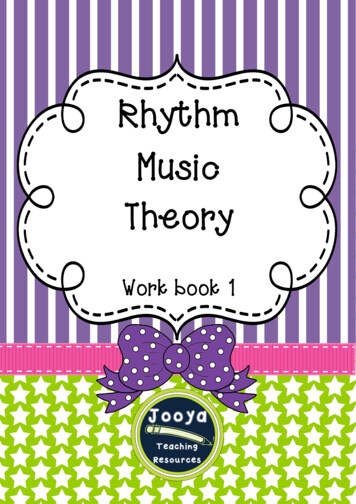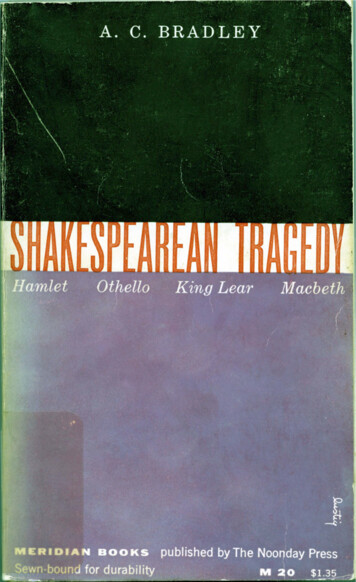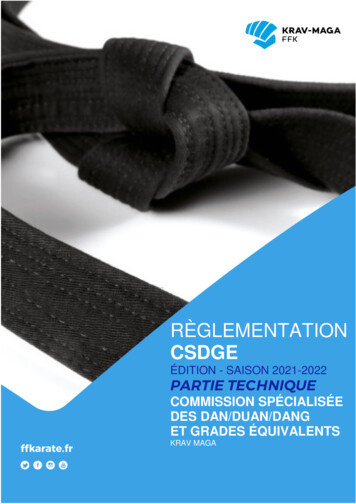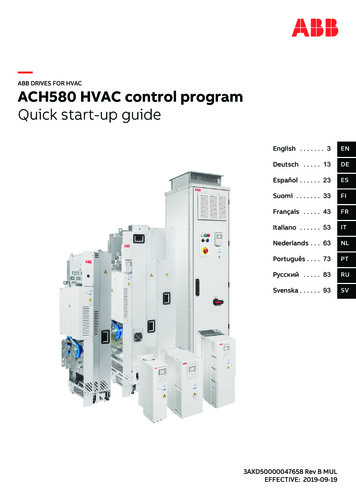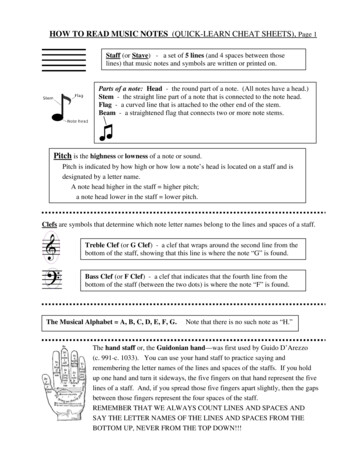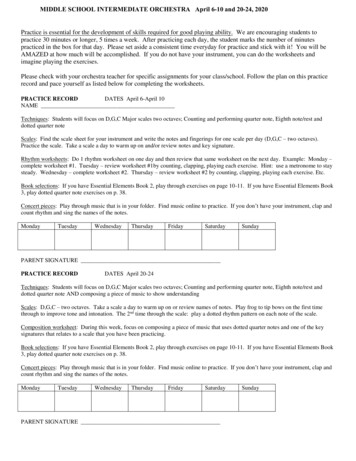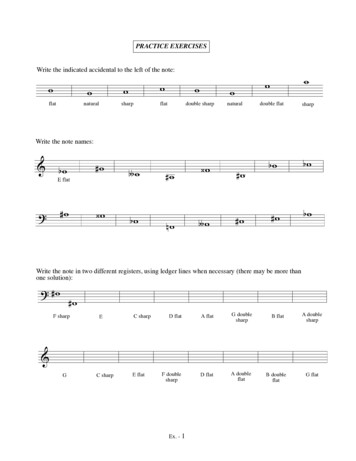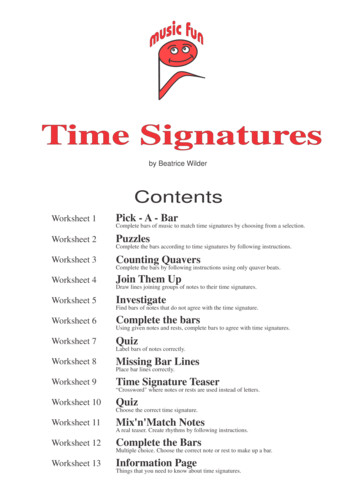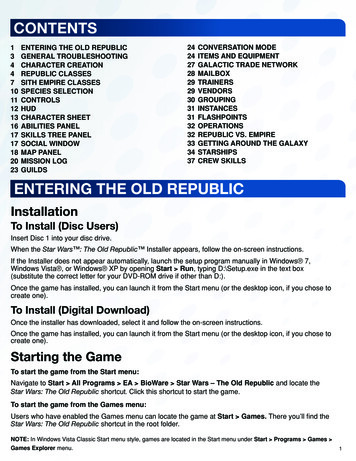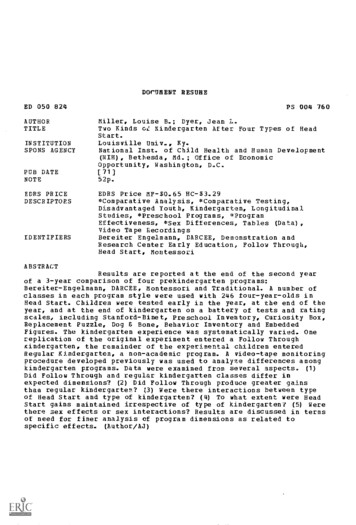
Transcription
DOCUMENT RESUHEED 050 824AUTHORTITLEPS 004 760Miller, Louise B.; Dyer, Jean L.Two Kinds cif Kindergarten After Four Types of HeadStart.INSTITUTIONSPONS AGENCYPUB DATENOTEEDRS PRICEDESCRIPTORSIDENTIFIERSLouisville Univ., Ky.National Inst. of Child Health and Human Development(NIH) , Bethesda, Md.; Office of EconomicOpportunity, Washington, D.C.[71]52p.EDRS Price MF- 0.65 HC- 3.29*Comparative Analysis, *Comparative Testing,Disadvantaged Youth, Kindergarten, LongitudinalStudies, *Preschool Programs, *ProgramEffectiveness, *Sex Differences Tables (Data),Video Tape RecordingsBereiter Engelmann, DARCEE, Demonstration andResearch Center Early Education, Follow Through,Head Start, MontessoriABSTRACTResults are reported at the end of the second yearof a 3-year comparison of four prekindergarten programs:Bereiter-Engelmann, DARCEE, Montessori and Traditional. A number ofclasses in each program style were used with 246 tour-year-olds inHead Start. Children were tested early in the year, at the end of theyear, and at the end of kindergarten on a battery of tests and ratingscales, including Stanford-Binet, Preschool Inventory, Curiosity Box,Replacement Puzzle, Dog E Bone, Behavior Inventory and EmbeddedFigures. The kindergarten experience was systematically varied. Onereplication of the original experiment entered a Follow Throughkindergarten, the remainder of the experimental children enteredRegular Kindergarten, a non-academic program. A video-tape monitoringProcedure developed previously was used to analyze differences amongkindergarten programs. Data were examined from several aspects. (1)Did Follow Through and regular kindergarten classes differ inexpected dimensions? (2) Did Follow Through produce greater gainsthan regular kindergarten? (3) Were there interactions between typeof Head Start and type of kindergarten? (4) To what extent were HeadStart gains maintained irrespective of type of kindergarten? (5) Werethere sex effects or sex interactions? Results are discussed in termsof need for finer analysis of program dimensions as related tospecific effects. (Author/AJ)
II. 7 DEPARTMENT OF HEALTH, EDUCATION& WELFAREOFFICE OF EDUCATIONTHIS DOCUMENT HAS BEEN REPRODUCED EXACTLY AS RECEIVED FROM THEPERSON OR ORGANIZATION ORIGINATINGIT. POINTS OF VIEW OR OPINIONSSTATED DO NOT NECESSARILY REPRESENTOFFICIAL OFFICE OF EDUCATIONPOSITIUi OR POLICY.c\JTWO KINDS OF KINDERGARTEI,coOAFTER FOUR TYPES OF HEAD START*LrNcl)Louise B. MillerJean L. DyerUniversity of LouisvilleLouisville, KentuckyABSTRACTResults are reported at the end of the second year ofa three-year comparison of four pre-kindergarten programs:Bereiter-Engelmann, DARCEE, Montessori and Traditional. Anumber of classes in each program style were used with fourChildren were tested early in theyear-olds in Head Start.year, at the end of the year, and at the end of kindergartenon a battery of tests and rating scales, including StanfordBinet, Preschool Inventory, Curiosity Box, Replaccment Puzzle,Dog & Bone, Behavior Inventory and Embedded Figures.Kindergarten experience was systematically varied -- onereplication of the original experiment entered a FollowThrough Kindergarten, the remainder of the experimentalchildren entered Regular Kindergarten, a non-academic program.A video-tape monitoring procedure developed previously wasused to analyze differences among kindergarten programs.Kindergarten data were examined from several aspects:(1)Did Follow- Through and Regular Kindergarten classesdiffer in expected dimensions? (2) Did Follow- Throughproduce greater gains than Regular Kindergarten? (3) Werethere interactions between type of Head Start and type ofkindergarten? (4) To what extent were Head Start gainsmaintained irrespective of type of kindergarten? (5) Werethere sex effects or sex interactions?71.4Results are discussed in terms of need for finer analysisof program dimensions as related to specific effects.NIP*as research has been supported by the Office of Economic Opportunity,and partially during the 1970-71 year by the National Institute ofChild Health and Development, U.S. Public Health Service.T'1
LIST OF TABLESPageNo.1Placement of Classes by Programs and Areas inHead Start22Variations in Kindergarten Year Experience53Distribution of Subjects in Monitored Classes inRegular Kindergarten aid Follow-Through74Adjusted Means on all Groups in Follow-Through andRegular Kindergarten on Main Battery95Means from Repeated Measures on All Data106Means from Repeated Measures on Additional TestsGiven Sample of Experimental Subjects117Means per 10-Minute Video-Tape Sample138Means per 10-Minute Video-Tape Sample114ii2
LIST OF FIGURESPageNo,12345615Informational Feedback (KOR and KOR-)Follow - Through versus Regular Kindergarten Teachers16"Asking" VariablesFollow-Through versus Regular Kindergarten Teachers17"Giving" VariablesFollow- Through versus Regular Kindergarten Teachers18Main Battery -- Follow-Through versus Regular KindergartenAll Experimental Subjects21Behavior Inventory Factors and Face Sheet Ratings onAchievement -- Follow-Through versus Regular Kindergarten227Main Battery and Additional Tests -- Follow - Through versusRegular Kindergarten. Controls Only238Measures which Differentiated Follow-Through end RegularKindergarten Children25Stanford-Binet IQ -- Head Start and KindergartenCombinations26Persistence, Replacement Puzzle A -- Head Start andKindergarten Combinations27Embedded Figures -- Interaction between Head Start andKindergarten Programs2CCuriosity-Activity -- Head Start Program Effect over bothTypes of Kindergarten309101112.Total Contacts to Group versus Individual -Follow- Through versus Regular Kindergarten Teachers1314Aggression (Behavior Inventory) -- Head Start ProgramEffect over both Types of Kindergarten31Arithmetic -- Head Start Program Stability afterKindergarten3215Inventiveness (Dog & Bone) -- Head Start Program Stabilityafter Kindergarten3316Resistance-to-Distraction (Replacement Puzzle B) -- MainEffect of Head Start Program over Three Testing Points.iii334
PageNo.171819202122Verbal- Social - ,Participation (Behavior Inventory) --Head Start Program Effect over both Types of Kindergarten, Combined Means for Three Testing Times35Curiosity-Activity -- Sex Effect over all Head StartPrograms and both Kinds of Kindergarten37Stanford-Binet IQ -- Sex Effect over all Head StartPrograms and both Kinds of Kindergarten38Stanford-Binet Reverse Head Start Program Order forMales and Females at end of Kindergarten39Parallel Sentence Production -- Interaction of Sex withHead Start Programs over both Kinds of Kindergarten ,.40Timidity (Behavior Inventory) -- Interaction of Sexwith Follow- Through or Regular Kindergarten414iv
1TUO KINDS OF KINDERGARTENAFTER FOUR TYPES OF HEAD STARTThis report presents the results of the second year of a threeyear longitudinal study comparing four types of preschool programsfor disadvantaged children.The mean goals et the research are: (1) to assess programcomponents (treatment dimensions), (2) to assess program effectson cognitive, motivational, social and perceptual development,and (3) to relate treatment dimensions to treatment effects.The four programs which were implemented in the pre-kindergartenyear (Head Start) were: Dereiter-Engelmann which emphasizes acquisitionof linguistic and numerical skills by use of verlbal instruction,imitation, and reinforcement, and de-emphasizes sensorial stimulationand manipulation; DARCEE which emphasizes, in addition to verbal andconceptual skills, hieof attitudes and motives relatedto learning, using verbalization, reinforcement, manipulation ofmaterials and imitation; Montessori which emphasizes development ofpersistence, independence, and self-discipline, in addition to conceptual skills, using sensorial stimulation, manipulation of materialsand self-selection, and de-emphasizes reinforcement and verbalization;Traditional (official Head Start Program) which emphasizes developmentin social and emotional areas, language skills and curiosity, usingmanipulation of materials, sensorial stimulation, role-playing andself-selection, and de-emphasizes verbal instruction and reinforcement.The study was designed to provide appropriate controls for teacherand population variables, and incorporated two control groups -- a nonpreschool group similar to the experimental sample and a middle-classgroup in a private preschool.1Fourteen classes were conducted during the 1968-69 school year -two Montessori classes and four classes in each of the other programstyles. Four-year-olds, randomly assigned within areas to Head Startclasses, were tested in the fall after about 8 weeks of school andagain Hin the spring.at the end of the school year. A number of instruments designed to assess gains in cognitive, motivational, social andperceptual development were used; five additional tests were adminiilteredat the end of the year primarily to assess specific skill-learning.Classes were monitored five times and also video-taped during the yearto assess treatment dimensions for both children and teachers. Thedesign of the study in the first year is shown in Table 1.12The middle-class control group was not obtained until the second yearand these results are not reported here.Tests used in kindergarten are listed in Appendix I.5
2TABLE 1PlacementCalifornfiaC1n.:7,s(?s by Proram:F nnd AreaJacksonin Head StartPark DuValleTotn1Prop:ramBereiter-1.2117171.;19Ely, elmn A1564J,12.53322)16
SUMMARY OF RESULTS - PRE-KINDERGARTEN1.Programs were found to differ significantly in a number ofdimensions with respect to behavior of both teachers and children,most of these differences being in predicted directions.In the Bereiter-EngeImann classes, teachers weresignificantly high in verbal instruction, exemplification,modeling of academic information, amount of feedbackgiven -- both positive and negative, and in the elicitation of verbal recitation from the children; DARCEEteachers were significantly high in verbal instruction,conversation with children and contingent positivereinforcement; Traditional teachers were significantlyhigh in manipulation of materials, conversation withchildren and asking for conduct. Bereiter-EngeImannand DARCEE children were significantly high in -verbalrecitation; Montessori children were significantly highin manipulation; Traditional children were significantlyhigh in role-playing.2,Programs had significantly different effects on children withrespect to a number of the variables measured.Bereiter-EngeImann and, to some extent, DARCEE significantly affected cognitive functioning as measured bythe Stanford-Binet and the Preschool Inventory; DARCEEhad considerable impact on children's motivation to achieve,persistence, resistance-to-distraction, initiative, andcuriosity; Montessori and Bereiter-EngeImann children weresignificantly higher than controls on curiosity. BereiterEngeImann produced significantly high achievement onsentence production and arithmetic; DARCEE was significantlyhigh on arithmetic.According to teachers' ratings aftersix months, DARCEE children were significantly high inverbal-social-participation and less timid than childrenin other programs. Bereiter-EngeIma'hildren were significantly less aggressive.ftlembnesommes-ame11101.
4DESIGN-KINDERGARTEN YEARThe variations in kindergarten for children from the four kindsof Head Start are shown in Table 2.One replication of the original study entered Follow-ThroughKindergarten; that is, one class from each of the four Head Startprogram styles. The remaining experimental groups entered RegularKindergarten.Follow-Through Kindergarten was a highly academic, individualizedprogram structured as a token-economy.The children studied reading(phonics and blends), handwriting and arithmetic.The school day wasbroken into "Earn" and "Spend" periods. Luring the "Earn" periodthe children were reinforced with tokens usually accompanied by verbalpraise.They accumulated these tokens and during the "Spend" periodthey were allowed to buy various kinds of activities and things toplay with.The classes were divided into small groups and childrenworked on the same kind of lesson at a given time, but each childworked on his OWR and at his own rate.The program, as implementedin Louisville, used the Sullivan reading materials, Addison-Wesleymathematics and Skinner handwriting program.These were supplementedby materials provided from the University of Kansas, including apre-reader. The program day lasted from 8:30 A.M. to 1:30 P.M.In Follow- Through Kindergarten there were 25 children in a class,one teacher, one teacher assistant and two parent-aides who alternatedover 8-week periods.Regular Kindergarten in the city schools has not been intendedas a preparation for first-grade work in any specific sense. Writtenmaterials and pre-reading exercises were not formally a part of theprogram. Officially the program attempted to provide a balancebetween cognitive and affective development.The Supervisor believedthat the key to its success was the teacher's awareness of the levelat which each individual child is functioning and the potential forlearning which exists in a variety of activities. The program mightbe described as a model of the type kindergarten after which officialHead Start was patterned. The school day lasted 212 hours, withclasses scheduled in both morning and afternoon. In some schools thesame teacher taught two classes -- one in the morning and one in theafternoon. Host teachers did not have aides and one teacher mighthandle more than 30 children in a class, but if the same teacher had60 or more children in two classes, an aide was provided. Volunteerswere utilized as fully as possible. Typically a class containedabout 25 children.This program was not federally funded.4J.J:
5TABLF 2Variations in Kindergarten Year Ex2oriencePre-KindergartenYear '1Aperience(1968-69)Regular Dereiter-EhgelmannHead Start31*l%45DARCEE head Start4015c'eMontessori Head Start201232Traditional Had Stzart,311243No Head Start (ControL)Total151 )4868216*An additional 14 experimental subjects from the original Bereiter-EngelmannHead Start cla:3s continued 1 th thin program in Kinderp:arten.
6METHODProcedureThe children from the four different Head Start programs weredistrilouted as equally as possible into four Follow-Through classesin order to control for the teacher variable. Placement of theremainder of the experimental subjects occurred without systematiccontrol and resulted in a wide distribution of subjects into 19schools and I0 kindergarten classes. Many of the classes containedonly one or two experimental children, however, and there was aconcentration of subjects in five Regular Kindergarten classes,Table 3 shows the distribution of children from the four Head Startprograms into these nine kindergarten classes.These nine classeswere video-taped three times during the year and the tapes weremonitored with the same instrument used in the first year of thestudy to monitor Head Start classes. (See Appendix, pages L8 and L9.)Three groups of testers administered the battery of tests tothe children at the end of the kindergarten year. A total of 200of the original experimental group and 31 of the original controlswere retested. An additional control group of 15 was obtained atthe and of the kindergarten year.These were children who enteredFollow-Through without having had any Head Start experience at all.As in the first phase of the study, data were obtained in twoareas: Treatment Dimensions and Treatment Effects.Specifically,these questions were asked:A.Treatment Dimensions(1)(2)B.Did Follow-Through and Regular Kindergarten classes,as implemented, manifest the expected emphases oncertain program components:Did Follow-Through and Regular Kindergarten classesdiffer in expected dimensions?Treatment Effects(1)(2)(3)(4)Did the academic Follow-Through Program produce greatergains in any of the dependent variables than theRegular Kindergarten?Were there interactions between type of Head Start andtype of kindergarten such that certain combinations weresuperior to others?To what extent were Head Start gains maintained,irrespective of type of kindergarten?Were males and females affected differently by type ofkindergarten or combinations of Head Start and kindergarten?10
7TABLE 3Distribution of albjecto in Monitored Classes inRegular Kindergarten and Follow-ThroughRegular KindergartenHead :tart 000170215328Traditional61310322321Controls02023 ,20521612121022913111815122TotalsTotal in other classes10!-;
8AnalysesVideo-tape data were subjected to a multivariate analysis ofOn a number of dimensions the variance for some teachersvariance.over three sessions was virtually zero -- that is, the teacher wassimply not engaging in a particular behavior at all. This resultedin extreme inhomogeneity of variance, of course, and for this reason,the data were also analyzed by means of the Mann - Whitney U-test.This non-parametric statistic confirmed results from the multivariateanalysis and produced some additional rank-order differences betweenprograms.In order to answer questions about dependent variables, a numberof different analyses were made. To compare Follow-Through andRegular Kindergarten, an analysis of covariance on the main batterywas made using the end-of-Head Start scores as the covariate. TheThisanalysis included Head Start program and sex as variables.analysis did not include the original control group because all ofthese children entered Regular Kindergarten rather than FollowThrough.There were 172 experimental children involved in thecovariance analysis, 121 in Regular Kindergarten and 51 in FollowThrough.A similar analysis was made for the three additional tests givento a sample of the Head Start children, again using end-of-Head Startscores as the covariate.This analysis included sex as a variable,but not Head Start program because of the small sample size and theextremely unequal Nis from the four Head Start programs in the twoic.nds of kindergarten. N for this analysis was 77.Since no previous test scores were available on the new controlsin Follow-Through, they could be compared with the original controls(all of whom entered Regular Kindergarten) only by analysis of varianceon the end-of-kindergarten scores, As a further check on the possibleeffects of. Follow-Through, this analysis was made on the main batteryand also on the additional tests given to the sample of Head Startchildren. N for this analysis was 39, 15 in Follow-Through and 24 inRegular Kindergarten.For the purpose of assessing stability of Head Start effects,without regard to type of kindergarten, a repeated measures analysisof variance was made, using all three data points.This analysisincluded Head Start program, the sex variable, and also included theoriginal control group.The number of subjects in this analysis was231.A repeated measures znalysis of variance was also made on thesample of subjects who were given three additional tests. N was 84.Table 4 presents adjusted means for all groups on allfrom the covariance analysis of Follow-Through vs. Regulargarten. Table 5 presents means at the three testing timesbattery for experimentals and controls. Table 6 shows thethe sub-sample on additional tests.12measuresKin:eron the mainmeans for
TABLE 49Ad jested Means on all Groups inFollow-Through and Regi,17.ar Kindergarten on Main BatteryBereiterEngelmannn 14N ntory49.7248.537.06.8Al]. SsTraditionalN N 53N .1148.057.36N-31BoneRepl.Puzzle A23.9323.9021.82/23.9922.0723.9024.0223.
Studies, *Preschool Programs, *Program Effectiveness, *Sex Differences Tables (Data), . (Author/AJ) II. 7 DEPARTMENT OF HEALTH, EDUCATION & WELFARE . in Louisville, used the Sullivan reading materials, Addison-Wesley mathematics
